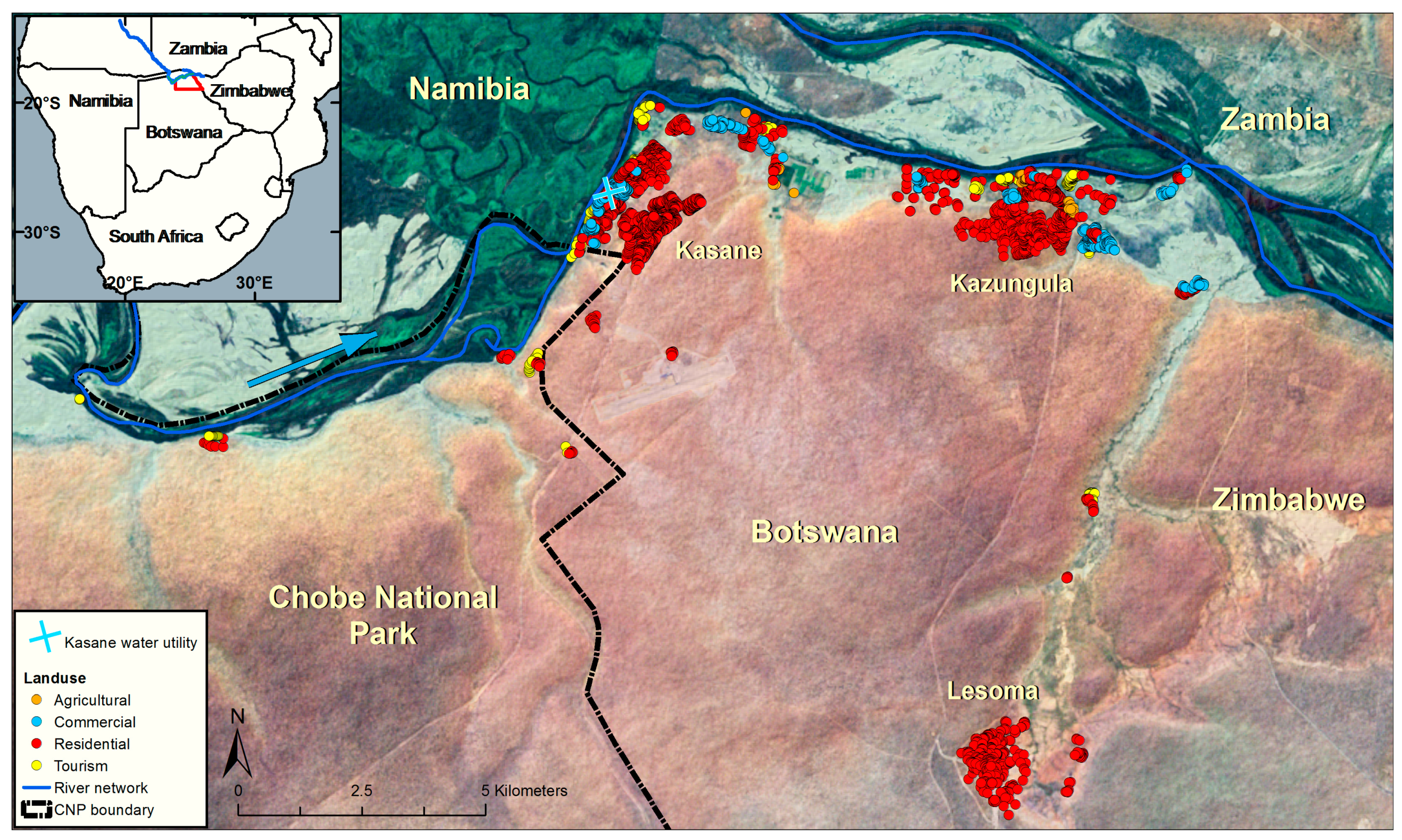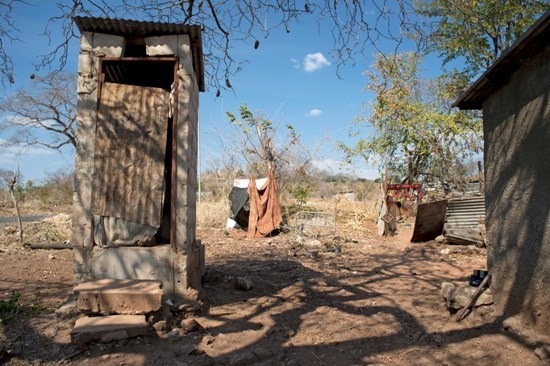Greywater Disposal Practices in Northern Botswana—The Silent Spring?
Abstract
:1. Introduction
The most alarming of all man’s assaults upon the environment is the contamination of air, earth, rivers, and sea with dangerous and even lethal materials. This pollution is for the most part irrecoverable; the chain of evil it initiates not only in the world that must support life but in living tissues is for the most part irreversible.—Rachel Carson, Silent Spring [1]
2. Experimental Section
2.1. Study Site

2.2. Household Surveys
2.3. Statistical Analysis
3. Results and Discussion
3.1. Greywater Disposal Practices

3.2. Greywater and Hydraulic Loading of the Pit Latrine—Environmental Impacts
3.3. Recommendations for Greywater Disposal
|
|
|
|
|
|
|
|
|
| Settlement Density | Greywater Generation Rate (ℓ/day) | Density (du/ha) | Plot Size (m2) | Greywater Disposal Option |
|---|---|---|---|---|
| Low | <500 | <10 | >800 | Soakaways at water collection points and stand pipes. |
| Low/Medium | 500–1500 | 10–30 | 300–800 | Soakaways must be installed at standpipes, if water is reticulated to the dwelling (yard or home) recommend connection to on- or off-site disposal system. |
| Medium/high | 1500–2500 | 30–50 | 150–300 | If water is reticulated to the dwelling (yard or home) connection to on- or off-site disposal system must be installed, formal washing areas must also be developed with appropriate disposal systems. |
| High | >2500 | >50 | <150 | Off-site disposal |
4. Conclusions
Acknowledgments
Author Contributions
Conflict of Interest
References
- Carson, R. Silent Spring; Houghton Mifflin Harcourt: New York, NY, USA, 2002. [Google Scholar]
- Cohen, B. Urbanization in developing countries: Current trends, future projections, and key challenges for sustainability. Technol. Soc. 2006, 28, 63–80. [Google Scholar] [CrossRef]
- Sclar, E.D.; Garau, P.; Carolini, G. The 21st century health challenge of slums and cities. Lancet 2005, 365, 901–903. [Google Scholar] [CrossRef]
- Imhof, B.; Muhlemann, J. Greywater Treatment on Household Level in Developing Countries—A State of the Art Review; Department of Environmental Sciences at the Swiss Federal Institute of Technology (ETH): Zurich, Switzerland, 2005. [Google Scholar]
- Katukiza, A.; Ronteltap, M.; Niwagaba, C.; Kansiime, F.; Lens, P. Grey water characterisation and pollutant loads in an urban slum. Int. J. Environ. Sci. Technol. 2015, 12, 423–436. [Google Scholar] [CrossRef]
- Ghaitidak, D.M.; Yadav, K.D. Characteristics and treatment of greywater—A review. Environ. Sci. Pollut. Res. 2013, 20, 2795–2809. [Google Scholar] [CrossRef] [PubMed]
- Eriksson, E.; Auffarth, K.; Henze, M.; Ledin, A. Characteristics of grey wastewater. Urban Water 2002, 4, 85–104. [Google Scholar] [CrossRef]
- Winter, K.; Spiegel, A.; Armitage, N.; Carden, K. Sustainable Options for Community Level Management of Greywater in Settlements without On-Site Waterborne Sanitation; WRC Report; Water Research Commission: Pretoria, South Africa, 2011. [Google Scholar]
- Carden, K.; Armitage, N.; Winter, K.; Sichone, O.; Rivett, U.; Kahonde, J. The use and disposal of greywater in the non-sewered areas of South Africa: Part 1—Quantifying the greywater generated and assessing its quality. Water SA 2007, 33. [Google Scholar] [CrossRef]
- Carden, K.; Armitage, N.; Winter, K.; Sichone, O.; Rivett, U. Understanding the Use and Disposal of Greywater in the Non-Sewered Areas of South Africa; Water Research Commission: Pretoria, South Africa, 2007. [Google Scholar]
- Ridderstolpe, P. Introduction to Greywater Management; EcoSanRes Programme: Stockholm, Sweden, 2004. [Google Scholar]
- Ottoson, J.; Stenström, T.A. Faecal contamination of greywater and associated microbial risks. Water Res. 2003, 37, 645–655. [Google Scholar] [CrossRef]
- Birks, R.; Hills, S. Characterisation of indicator organisms and pathogens in domestic greywater for recycling. Environ. Monit. Assess. 2007, 129, 61–69. [Google Scholar] [CrossRef] [PubMed]
- Rose, J.B.; Sun, G.-S.; Gerba, C.P.; Sinclair, N.A. Microbial quality and persistence of enteric pathogens in graywater from various household sources. Water Res. 1991, 25, 37–42. [Google Scholar] [CrossRef]
- Govender, T.; Barnes, J.M.; Pieper, C.H. Contribution of water pollution from inadequate sanitation and housing quality to diarrheal disease in low-cost housing settlements of cape town, South Africa. Am. J. Public Health 2011, 101. [Google Scholar] [CrossRef] [PubMed]
- Carden, K.; Armitage, N.; Winter, K.; Sichone, O.; Rivett, U. The management of greywater in the non-sewered areas of South Africa. Urban Water J. 2008, 5, 329–343. [Google Scholar] [CrossRef]
- Carden, K.; Armitage, N.; Sichone, O.; Winter, K. The use and disposal of greywater in the non-sewered areas of South Africa: Part 2—Greywater management options. Water SA 2007, 33. [Google Scholar] [CrossRef]
- Graham, N. A review of Infrastructure Services for the Upgrading of South African Informal Settlements. Master’s Thesis, University of Cape Town, Cape Town, South Africa, 2003. [Google Scholar]
- Mekonnen, M.M.; Hoekstra, A.Y. National Water Footprint Accounts: The Green, Blue and Grey Water Footprint of Production and Consumption; Value of Water Research Report Series No. 50; UNESCO-IHE Institute for Water Education: Delft, The Netherlands, 2011; p. 50. [Google Scholar]
- Jobbins, S.E.; Alexander, K.A. From whence they came—Antibiotic-resistant Escherichia coli in African wildlife. J. Wildl. Dis. 2015, 51, 811–820. [Google Scholar] [CrossRef] [PubMed]
- Pesapane, R.; Ponder, M.; Alexander, K. Tracking pathogen transmission at the human-wildlife interface: Banded mongoose and Escherichia coli. Ecohealth 2013, 10, 115–128. [Google Scholar] [CrossRef] [PubMed]
- Botswana Government, Central Statistics Office. 2011 Botswana Population and Housing Census Alphabetical Index of Villages; Government Press: Gaborone, Botswana, 2011.
- Gaughan, A.; Waylen, P. Spatial and temporal precipitation variability in the Okavango‚ Kwando‚ Zambezi catchment, southern Africa. J. Arid Environ. 2012, 82, 19–30. [Google Scholar] [CrossRef]
- Google Earth. Available online: https://www.google.com/earth/ (accessed on 1 August 2010).
- Jacks, G.; Sefe, F.; Carling, M.; Hammar, M.; Letsamao, P. Tentative nitrogen budget for pit latrines‚ äìeastern Botswana. Environ.Geol. 1999, 38, 199–203. [Google Scholar] [CrossRef]
- Still, D.; Nash, S. Groundwater Contamination due to Pit Latrines Located in a Sandy Aquifer: A Case Study from Maputaland; Water Institute of Southern Africa Biennial Conference: Durban, South Africa, 2002; pp. 1–6. [Google Scholar]
- Ahaneku, I.E.; Adeoye, P.A. Impact of pit latrines on groundwater quality of Fokoslum, Ibadan, southwestern Nigeria. Brit. J. Appl. Sci. Technol. 2014, 4, 440–449. [Google Scholar] [CrossRef]
- Frieden, T.R.; Damon, I.; Bell, B.P.; Kenyon, T.; Nichol, S. Ebola 2014—New challenges, new global response and responsibility. N. Engl.J. Med. 2014, 371, 1171–1180. [Google Scholar] [CrossRef] [PubMed]
- Anyamba, A.; Chretien, J.-P.; Small, J.; Tucker, C.J.; Formenty, P.B.; Richardson, J.H.; Britch, S.C.; Schnabel, D.C.; Erickson, R.L.; Linthicum, K.J. Prediction of a rift valley fever outbreak. Proc. Natl. Acad. Sci. USA 2009, 106, 955–959. [Google Scholar] [CrossRef] [PubMed]
- Nichols, D.S.; Prettyman, D.; Gross, M. Movement of bacteria and nutrients from pit latrines in the boundary waters canoe area wilderness. Water Air Soil Pollut. 1983, 20, 171–180. [Google Scholar] [CrossRef]
- Stiles, C.; Crohurst, H. The principles underlying the movement of Bacillus coli in ground water with resultant pollution of wells. Public Health Rep. 1923, 38, 1350–1353. [Google Scholar] [CrossRef]
- McCoy, E.; Rahe, T.; Kling, G.; Hagedorn, C. Transport of antibiotic-resistant Escherichia coli through western oregon hillslope soils under conditions of saturated flow. J. Environ. Qual. 1978, 7, 487–494. [Google Scholar]
- Hagedorn, C.; Hansen, D.T.; Simonsson, G.H. Survival and movement of fecal indicator bacteria in soil under conditions of saturated flow. J. Environ. Qual. 1978, 7, 55–60. [Google Scholar] [CrossRef]
- Gerba, C.P. Fate of waste water bacteria and viruses in soil. J. Irrig. Drain. Div. 1975, 101, 157–173. [Google Scholar]
- Almqvist, H.; Hanæus, J. Organic hazardous substances in graywater from Swedish households. J. Environ. Eng. 2006, 132, 901–908. [Google Scholar] [CrossRef]
- Jeyes Fluid, Safety Data Sheet. Available online: http://dchd.co.uk/admin/SDS_JeyesFluid1L.pdf (accessed on 13 September 2015).
- Carballa, M.; Omil, F.; Lema, J.M.; Llompart, M.A.; Garcı́a-Jares, C.; Rodrı́guez, I.; Gomez, M.; Ternes, T. Behavior of pharmaceuticals, cosmetics and hormones in a sewage treatment plant. Water Res. 2004, 38, 2918–2926. [Google Scholar] [CrossRef] [PubMed]
- Heberer, T. Tracking persistent pharmaceutical residues from municipal sewage to drinking water. J. Hydrol. 2002, 266, 175–189. [Google Scholar] [CrossRef]
- Esrey, S.A. Towards a recycling society: Ecological sanitation-closing the loop to food security. Water Sci. Technol. 2001, 43, 177–187. [Google Scholar] [PubMed]
- Madungwe, E.; Sakuringwa, S. Greywater reuse: A strategy for water demand management in harare? Phys. Chem. Earth Parts A/B/C 2007, 32, 1231–1236. [Google Scholar] [CrossRef]
- Sigel, K.; Altantuul, K.; Basandorj, D. Household needs and demand for improved water supply and sanitation in peri-urban ger areas: The case of Darkhan, Mongolia. Environ. Earth Sci. 2012, 65, 1561–1566. [Google Scholar] [CrossRef]
© 2015 by the authors; licensee MDPI, Basel, Switzerland. This article is an open access article distributed under the terms and conditions of the Creative Commons Attribution license (http://creativecommons.org/licenses/by/4.0/).
Share and Cite
Alexander, K.A.; Godrej, A. Greywater Disposal Practices in Northern Botswana—The Silent Spring? Int. J. Environ. Res. Public Health 2015, 12, 14529-14540. https://doi.org/10.3390/ijerph121114529
Alexander KA, Godrej A. Greywater Disposal Practices in Northern Botswana—The Silent Spring? International Journal of Environmental Research and Public Health. 2015; 12(11):14529-14540. https://doi.org/10.3390/ijerph121114529
Chicago/Turabian StyleAlexander, Kathleen A., and Adil Godrej. 2015. "Greywater Disposal Practices in Northern Botswana—The Silent Spring?" International Journal of Environmental Research and Public Health 12, no. 11: 14529-14540. https://doi.org/10.3390/ijerph121114529
APA StyleAlexander, K. A., & Godrej, A. (2015). Greywater Disposal Practices in Northern Botswana—The Silent Spring? International Journal of Environmental Research and Public Health, 12(11), 14529-14540. https://doi.org/10.3390/ijerph121114529







